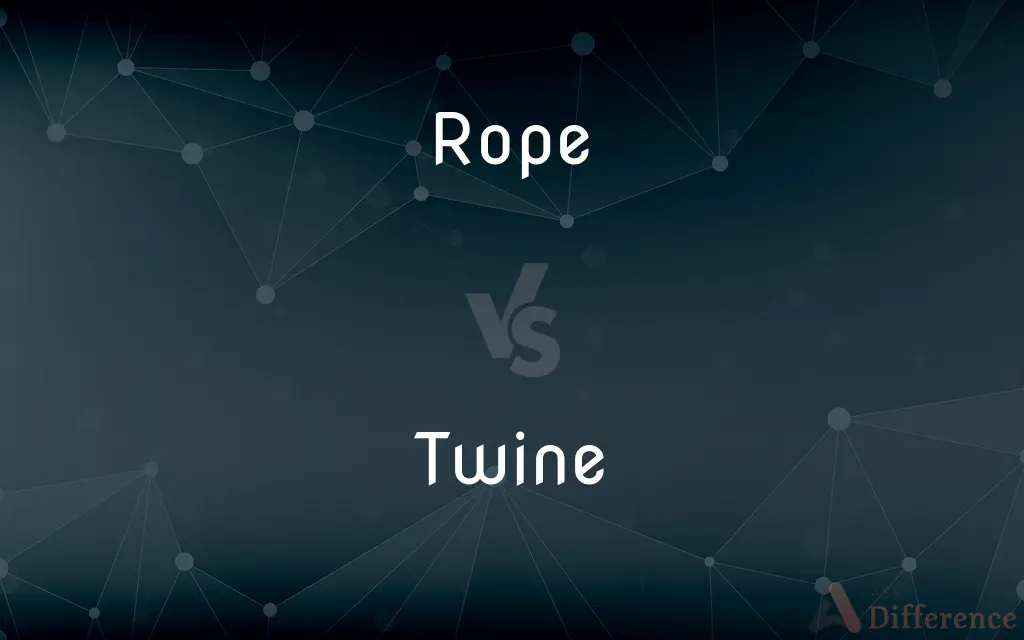Rope vs. Twine — What's the Difference?
By Maham Liaqat & Fiza Rafique — Updated on March 10, 2024
Rope is a thick, strong cord made from twisted or braided strands, used for heavy lifting or securing, while twine is thinner, used for tying or light binding, emphasizing flexibility and delicate tasks.

Difference Between Rope and Twine
Table of Contents
ADVERTISEMENT
Key Differences
Rope is typically constructed from multiple strands of material twisted or braided together to form a durable and robust cord. It is designed for heavy-duty applications such as climbing, securing objects, or towing. Twine, on the other hand, is much thinner and less robust, made for tying, bundling, or delicate tasks where a lighter touch is required. The difference in thickness and strength makes each suitable for specific tasks.
Materials used in rope manufacturing can include natural fibers like hemp or sisal and synthetic fibers such as nylon or polypropylene, giving it the strength needed for demanding tasks. Twine, while also available in both natural and synthetic fibers, is often preferred in natural forms like cotton or jute for tasks requiring biodegradability, such as gardening.
The construction of rope often involves complex braiding or twisting to enhance strength and resistance to wear, making it suitable for situations where safety or heavy loads are a concern. Twine's construction is simpler, focusing on flexibility and ease of use for tasks like tying parcels or crafts, where strength is not the primary concern.
Usage contexts also differentiate these two; rope is essential in maritime, climbing, and construction industries for its ability to handle heavy loads and resist breaking under tension. Twine is favored in agriculture, packaging, and DIY projects for its ease of tying and cutting, and for securing light loads without damage.
Despite their differences, both rope and twine are versatile tools in their respective domains, with the choice between them depending on the strength, durability, and flexibility required by the task at hand.
ADVERTISEMENT
Comparison Chart
Thickness
Thick and robust
Thin and lightweight
Strength
High, suitable for heavy lifting and securing
Lower, intended for tying and light binding
Material
Natural and synthetic fibers
Often preferred in natural fibers
Construction
Complex braiding or twisting
Simpler, focusing on flexibility
Usage Context
Maritime, climbing, construction
Agriculture, packaging, DIY projects
Compare with Definitions
Rope
Essential in industries like maritime and construction.
Sailors use ropes for various tasks aboard ships.
Twine
A thin thread of two or more small strands twisted together.
She tied the parcel with twine.
Rope
A thick cord made by twisting or braiding strands together.
The climber secured the rope to the anchor.
Twine
Suitable for delicate tasks requiring a lighter touch.
Twine is used to tie herbs for drying.
Rope
Known for its strength and versatility.
Rope bridges are a testament to the material's robustness.
Twine
Often made from natural materials like cotton or jute.
Jute twine is popular for its biodegradability.
Rope
Used for heavy-duty applications such as towing or securing.
The workers used a rope to lift the heavy crate.
Twine
Favored for its flexibility and ease of use in crafts.
Twine is a common material in DIY decoration projects.
Rope
Can be made from natural or synthetic materials.
Nylon ropes are preferred for their strength and durability.
Twine
Used for tying and light binding applications.
Gardeners use twine to support plants as they grow.
Rope
A rope is a group of yarns, plies, fibers or strands that are twisted or braided together into a larger and stronger form. Ropes have tensile strength and so can be used for dragging and lifting.
Twine
Twine is a strong thread, light string or cord composed of two or more thinner strands twisted, and then twisted together (plied). The strands are plied in the opposite direction to that of their twist, which adds torsional strength to the cord and keeps it from unravelling.
Rope
A flexible heavy cord of tightly intertwined hemp or other fiber.
Twine
Strong thread or string consisting of two or more strands of hemp or cotton twisted together.
Rope
A string of items attached in one line, especially by twisting or braiding
A rope of onions.
Twine
An instance of moaning or complaining
Having a good twine today—well, I am British and we do love complaining!
Rope
A sticky glutinous formation of stringy matter in a liquid.
Twine
Wind or cause to wind round something
She twined her arms round his neck
The plant will twine round its support
Rope
A cord with a noose at one end for hanging a person.
Twine
Moan; complain
Stop twining on about the snow
Sorry—I don't mean to moan at you. I've twined about it enough over the years
Rope
Execution or death by hanging
To die by the rope.
Twine
To twist together (threads, for example); intertwine.
Rope
A lasso or lariat.
Twine
To form by twisting, intertwining, or interlacing
Twined the cord from plant fibers.
Rope
Ropes(Sports) Several cords strung between poles to enclose a boxing or wrestling ring.
Twine
To encircle or coil about
A vine twining a tree.
Rope
Ropes(Informal) Specialized procedures or details
Learn the ropes.
Know the ropes.
Twine
To wind, coil, or wrap around something
"She was twining a wisp of hair very slowly around her fingers" (Anne Tyler).
Rope
(Baseball) A line drive.
Twine
To become twisted, interlaced, or interwoven
The branches of one tree twined with those of another.
Rope
To tie, fasten, or attach with a rope or other cord.
Twine
To go in a winding course; twist about
A stream twining through the forest.
Rope
To enclose, separate, or partition with a rope or other cord
Rope off the scene of the crime.
Twine
To wind or coil about something
Morning glories twining about stakes.
Rope
To catch with a rope or lasso.
Twine
A strong string or cord made of two or more threads twisted together.
Rope
(Informal) To persuade or manipulate (someone)
My boss roped me into attending the ceremony.
Twine
Something formed by twining
A twine of leaves.
Rope
(uncountable) Thick strings, yarn, monofilaments, metal wires, or strands of other cordage that are twisted together to form a stronger line.
Nylon rope is usually stronger than similar rope made of plant fibers.
Twine
A twist; a convolution.
Rope
(countable) An individual length of such material.
The swinging bridge is constructed of 40 logs and 30 ropes.
Twine
A strong thread composed of two or three smaller threads or strands twisted together, and used for various purposes, as for binding small parcels, making nets, and the like; a small cord or string.
Rope
A cohesive strand of something.
The duchess wore a rope of pearls to the soirée.
Twine
The act of twining or winding round.
Rope
A shot of semen that a man releases during ejaculation.
Twine
Intimate and suggestive dance gyrations.
Rope
(dated) A continuous stream.
Twine
(transitive) To weave together.
Rope
(baseball) A hard line drive.
He hit a rope past third and into the corner.
Twine
(transitive) To wind, as one thread around another, or as any flexible substance around another body.
Rope
(ceramics) A long thin segment of soft clay, either extruded or formed by hand.
Twine
(transitive) To wind about; to embrace; to entwine.
Rope
(computer science) A data structure resembling a string, using a concatenation tree in which each leaf represents a character.
Twine
(intransitive) To mutually twist together; to become mutually involved; to intertwine.
Rope
A kind of chaff material dropped to interfere with radar consisting of foil strips with paper chutes attached.
Twine
(intransitive) To wind; to bend; to make turns; to meander.
Rope
(Jainism) A unit of distance equivalent to the distance covered in six months by a god flying at ten million miles per second.
Twine
(intransitive) To ascend in spiral lines about a support; to climb spirally.
Many plants twine.
Rope
(jewelry) A necklace of at least 1 meter in length.
Twine
(obsolete) To turn round; to revolve.
Rope
(nautical) Cordage of at least 1 inch in diameter, or a length of such cordage.
Twine
(obsolete) To change the direction of.
Rope
(archaic) A unit of length equal to 20 feet.
Twine
(obsolete) To mingle; to mix.
Rope
(slang) Rohypnol.
Twine
A twist; a convolution.
Typhon huge, ending in snaky twine.
Rope
Semen being ejaculated.
Twine
A strong thread composed of two or three smaller threads or strands twisted together, and used for various purposes, as for binding small parcels, making nets, and the like; a small cord or string.
Rope
(with "the") Death by hanging.
The murderer was sentenced to the rope.
Twine
The act of twining or winding round.
Rope
(in the plural) The small intestines.
The ropes of birds
Twine
To twist together; to form by twisting or winding of threads; to wreathe; as, fine twined linen.
Rope
(transitive) To tie (something) with rope.
The robber roped the victims.
Twine
To wind, as one thread around another, or as any flexible substance around another body.
Let me twineMine arms about that body.
Rope
(transitive) To throw a rope (or something similar, e.g. a lasso, cable, wire, etc.) around (something).
The cowboy roped the calf.
Twine
To wind about; to embrace; to entwine.
Let wreaths of triumph now my temples twine.
Rope
(intransitive) To climb by means of a rope or ropes.
Twine
To change the direction of.
Rope
(intransitive) To be formed into rope; to draw out or extend into a filament or thread.
Twine
To mingle; to mix.
Rope
To commit suicide, particularly by hanging.
My life is a mess; I might as well rope.
Twine
To mutually twist together; to become mutually involved.
Rope
A large, stout cord, usually one not less than an inch in circumference, made of strands twisted or braided together. It differs from cord, line, and string, only in its size. See Cordage.
Twine
To wind; to bend; to make turns; to meander.
As rivers, though they bend and twine,Still to the sea their course incline.
Rope
A row or string consisting of a number of things united, as by braiding, twining, etc.; as, a rope of onions.
Twine
To turn round; to revolve.
Rope
The small intestines; as, the ropes of birds.
Twine
To ascend in spiral lines about a support; to climb spirally; as, many plants twine.
Rope
To be formed into rope; to draw out or extend into a filament or thread, as by means of any glutinous or adhesive quality.
Let us not hang like ropingiciclesUpon our houses' thatch.
Twine
A lightweight cord
Rope
To bind, fasten, or tie with a rope or cord; as, to rope a bale of goods.
Twine
Spin or twist together so as to form a cord;
Intertwine the ribbons
Twine the threads into a rope
Rope
To connect or fasten together, as a party of mountain climbers, with a rope.
Twine
Coil around;
Wisteria twining the fence posts
Rope
To partition, separate, or divide off, by means of a rope, so as to include or exclude something; as, to rope in, or rope off, a plot of ground; to rope out a crowd.
Twine
Wrap or coil around;
Roll your hair around your finger
Twine the thread around the spool
Rope
To lasso (a steer, horse).
Twine
Make by twisting together or intertwining;
Twine a rope
Rope
To draw, as with a rope; to entice; to inveigle; to decoy; as, to rope in customers or voters.
Twine
Form into a spiral shape;
The cord is all twisted
Rope
To prevent from winning (as a horse), by pulling or curbing.
Rope
A strong line
Rope
Street names for flunitrazepan
Rope
Catch with a lasso;
Rope cows
Rope
Fasten with a rope;
Rope the bag securely
Common Curiosities
What is the main difference between rope and twine?
The main difference lies in their thickness and strength, with rope being thicker and stronger for heavy-duty tasks and twine being thinner and lighter for tying and delicate applications.
Can twine be used in place of rope for climbing?
No, twine is not suitable for climbing due to its lower strength and durability compared to rope.
Is twine environmentally friendly?
Twine made from natural materials like cotton or jute is biodegradable and considered environmentally friendly.
What are some creative uses for twine?
Twine can be used creatively in crafts, such as making twine balls, wrapping gifts, or creating decorative knots.
Are ropes only made from synthetic materials?
No, ropes can be made from both natural and synthetic materials, chosen based on the required strength and application.
Is there a significant price difference between rope and twine?
Generally, rope is more expensive than twine due to its thicker construction and materials used, but prices vary based on type and quality.
Why is rope preferred for maritime applications?
Rope is preferred in maritime applications for its strength, durability, and resistance to wear, essential qualities for safety and functionality at sea.
How do I care for and maintain my rope?
Store rope away from direct sunlight and moisture, and inspect regularly for signs of wear or damage, especially if used for safety-critical applications.
Can I use twine for gardening?
Yes, twine is commonly used in gardening for tying plants, marking rows, and other light binding tasks where its flexibility and biodegradability are beneficial.
How do I choose between rope and twine for a project?
Choose based on the strength and flexibility needed for your task; use rope for heavy-duty or safety-critical applications and twine for tying, bundling, or crafts.
Can twine be used for packaging?
Yes, twine is often used for packaging, especially for tying parcels and gifts, due to its aesthetic appeal and sufficient strength for such tasks.
Can synthetic twine be recycled?
Some synthetic twines can be recycled, depending on the material, but recycling facilities and policies vary, so it's best to check locally.
How can I determine the load capacity of a rope or twine?
Load capacity depends on the material, construction, and thickness of the rope or twine. Refer to manufacturer specifications or consult with a professional for accurate load capacity.
What type of rope is best for outdoor use?
Synthetic ropes like nylon or polypropylene are best for outdoor use due to their resistance to water, rot, and UV damage.
Are there any safety concerns with using rope or twine?
Yes, always ensure the rope or twine is suitable for the load it will bear to prevent accidents, especially in applications like climbing or lifting.
Share Your Discovery

Previous Comparison
Hindrance vs. Hurdle
Next Comparison
Pat vs. PotAuthor Spotlight
Written by
Maham LiaqatCo-written by
Fiza RafiqueFiza Rafique is a skilled content writer at AskDifference.com, where she meticulously refines and enhances written pieces. Drawing from her vast editorial expertise, Fiza ensures clarity, accuracy, and precision in every article. Passionate about language, she continually seeks to elevate the quality of content for readers worldwide.















































